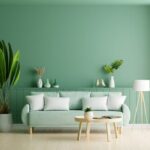Are you a beginner looking to embark on a new home decorating project? Look no further. This article is your ultimate beginners guide to home decorating. Your living space is a reflection of your personality and style, so it’s crucial to create a space that resonates with you. Home decor not only enhances the aesthetics of your surroundings but also plays a significant role in influencing your mood and overall well-being.
Understanding your personal style is the first step towards creating a space that feels like home. Whether you lean towards modern, minimalist, or traditional design styles, it’s important to identify what resonates with you.
Once you’ve established your personal aesthetic, budgeting and planning come into play. Setting a budget for your home decorating projects and planning out the overall look and feel of your space will guide you in making informed decisions as you begin transforming your living area.
From selecting key furniture pieces to incorporating color and texture into your decor, this guide will provide valuable tips for bringing life to every corner of your home. We’ll also delve into the importance of space layout and flow, as well as offer beginner-friendly DIY projects and budget-friendly tips to spruce up your space.
So, if you’re ready to dive into the world of home decorating, keep reading for essential advice and resources to help bring your interior design dreams to life.
Setting the Foundation
When it comes to home decorating, understanding your personal style is crucial. Your home should be a reflection of your personality and taste, creating a space that brings joy and comfort to you and your family. Here are some tips for beginners on how to understand and define your personal style in home decorating:
- Identify different interior design styles: Before diving into the world of home decor, take some time to familiarize yourself with different interior design styles such as modern, traditional, bohemian, minimalistic, and more. Look at photos of each style and take note of what elements resonate with you.
- Discover your own personal aesthetic: Pay attention to the colors, patterns, and textures that catch your eye. Consider the clothes you wear and the art you appreciate when defining your personal style. Are you drawn to soft pastels or bold primary colors? Do you prefer clean lines or intricate details? These preferences can give you valuable insight into your unique aesthetic.
Budgeting and Planning
Setting a budget for home decorating projects is an essential step for beginners looking to revamp their living space. It’s important to determine how much you are willing to spend on different aspects of your home decor, including furniture, paint, and accessories. By establishing a budget early on, you can prioritize where to allocate your funds and avoid overspending.
Once you have determined your budget, it’s time to plan out the overall look and feel of your space. Consider the style and atmosphere you want to achieve in each room of your home. Are you aiming for a cozy, rustic feel in the living room? Or perhaps a minimalist, modern vibe in the bedroom? It’s important to have a clear vision of how you want each space to look so that you can make informed purchasing decisions.
Creating a decor plan also involves taking measurements of your rooms and making note of any existing furniture or decor that will stay in place. This will help you determine what items need to be replaced or added to complete the desired aesthetic.
Additionally, consider creating mood boards or Pinterest inspiration boards to gather ideas and visualize how different elements will come together in your space. By carefully planning out your decor, you can ensure that every purchase contributes to the cohesive look and feel you want to achieve.
By taking these steps in budgeting and planning, beginners can begin their home decorating journey with confidence and clarity about their personal style and the atmosphere they want their living space to exude. With these foundational aspects in place, selecting key pieces, incorporating color and texture, maximizing space layout and flow, as well as tackling DIY projects will become more manageable and enjoyable.
Selecting Key Pieces
When it comes to home decorating, selecting the right furniture and decor essentials is crucial in creating a space that reflects your personal style. For beginners, it can be overwhelming to know where to start when choosing key pieces for your home. However, with some guidance and tips, you can easily navigate through the process and make informed decisions.
To begin, consider the essential furniture pieces for different rooms in your home. Here are some key pieces to keep in mind:
- Living Room: A comfortable sofa or sectional, a coffee table, and accent chairs
- Bedroom: A quality bed frame and mattress, bedside tables, and a dresser or wardrobe
- Dining Room: A dining table and chairs or a dining set
- Home Office: A desk and a comfortable chair
Once you have identified the essential furniture pieces for each room, it’s time to select decor accents that complement your personal style. This can include artwork, rugs, cushions, throws, curtains or blinds, lighting fixtures, and decorative accessories. When choosing these decor accents, keep in mind the overall look and feel you want to achieve in each room.
It’s important to consider functionality as well as aesthetics when selecting key pieces for your home. Think about how each piece will be used on a daily basis and how it will contribute to the comfort and functionality of your living space. By carefully choosing furniture and decor essentials that align with your personal style and meet your practical needs, you can create a cohesive and inviting environment in your home.
Color and Texture
When it comes to home decorating, color and texture play a crucial role in creating the desired atmosphere and mood in a room. Choosing the right color scheme and incorporating diverse textures can elevate the visual appeal of your space, making it feel inviting and harmonious. Whether you prefer a bold, vibrant look or a more minimalist and calming ambiance, understanding the power of these visual elements is key to achieving your desired home decor style.
Impact of Color
Color has the ability to evoke certain emotions and set the tone for a room. For instance, warm tones such as reds, oranges, and yellows can create a cozy and energetic vibe, while cool tones like blues and greens can promote relaxation and tranquility.
Understanding the psychology of color can help you select hues that align with the mood you want to foster in different areas of your home. Additionally, experimenting with accent colors can add visual interest and personality to your space.
Embracing Texture
Incorporating various textures into your decor adds depth and character to your space. From smooth, glossy surfaces to rough, tactile materials, mixing textures creates a multi-dimensional look that is visually stimulating. Consider adding elements like plush rugs, rustic wooden furniture, sleek metal accents, or soft textiles like drapes and pillows to introduce tactile variety. Combining different textures not only enhances the overall aesthetic but also adds a sense of warmth and comfort to any room.
Incorporating Complementary Elements
When working with color and texture in home decorating, it’s important to ensure that they complement each other cohesively. Harmonizing different textures through mindful layering can create balance within your space, while coordinating colors effectively ties the overall look together. Whether through contrasting or monochromatic palettes, finding ways to seamlessly blend varying elements will enhance the visual appeal of your decor while fostering an inviting atmosphere for both residents and guests.
Understanding how color and texture influence the overall ambiance of your home is essential for beginner decorators looking to craft their own personal style. By recognizing the impact of these visual elements on mood and atmosphere, individuals can make informed decisions when choosing colors schemes, furnishings,and decor accents for their homes.
Space Layout and Flow
When it comes to home decorating, one of the key elements to consider is the layout and flow of your space. Proper space planning can make a significant impact on how you experience and move through your home. For beginners, understanding the basics of space layout and flow can be instrumental in creating a harmonious and functional living environment.
Before diving into any major decorating projects, it’s important to assess the layout of your home and how you currently utilize the space. Consider the functionality of each room and how you want to feel when you’re in that space. This will help you determine what areas need improvement or reorganization.
Once you have a clear understanding of your space and its purpose, you can start thinking about ways to maximize functionality and create a seamless flow from one area to another. This may involve rearranging furniture, adding storage solutions, or even implementing simple design techniques such as creating clear pathways.
Ultimately, proper space layout and flow are essential to achieving a well-designed and comfortable home. Taking the time to carefully plan out the flow of each room will not only improve the aesthetic appeal but also enhance your overall living experience.
| Aspect | Description |
|---|---|
| Space Layout | Assess the current layout of your home |
| Functionality | Determine how each room is currently being used and ways it could be improved |
| Flow | Create clear pathways and consider how different areas transition into one another |
DIY Projects and Decor Tips
For those just starting out on their home decorating journey, DIY projects can be a fun and budget-friendly way to add personal touches to your space. Whether it’s creating your own wall art, upcycling old furniture, or adding decorative accents, there are plenty of beginner-friendly projects to try. DIY projects not only allow you to customize your home decor but also provide a sense of accomplishment and pride in your space.
When it comes to decor tips, one important thing for beginners to remember is to start with small changes and then build from there. It’s easy to get overwhelmed by the idea of completely redecorating a room, so focusing on one area at a time can make the process more manageable. Additionally, don’t be afraid to experiment with different styles and decor trends – ultimately, your home should reflect your unique personality and taste.
In terms of resources, there are countless online tutorials, blogs, and social media accounts dedicated to DIY home decor ideas. Pinterest is an excellent platform for inspiration and ideas for all skill levels. Additionally, many home improvement stores offer workshops and classes for beginners looking to sharpen their DIY skills. Taking advantage of these resources can help you gain confidence in your decorating abilities while also providing practical knowledge for future projects.
| DIY Projects | Decor Tips |
|---|---|
| Creating wall art | Start with small changes |
| Upcycling old furniture | Experiment with different styles |
| Adding decorative accents | Use online tutorials and workshops as resources |
Resources and Further Reading
In conclusion, the key to successful home decorating lies in understanding your personal style, creating a decor plan, selecting key pieces of furniture and decor, playing with color and texture, optimizing space layout and flow, and getting creative with DIY projects. As this article has shown, home decorating is not just about making your space look nice; it’s about creating a place that reflects who you are and brings you joy every time you walk through the door.
For beginners looking to dive into the world of home decorating, it’s important to take the time to explore different interior design styles and determine what truly resonates with you. It’s also crucial to set a budget for your projects and plan out the overall look and feel of your space before diving into any purchases or renovations.
Additionally, don’t be afraid to seek inspiration from various resources such as books, websites, and online retailers. By expanding your knowledge and exploring different options, you can make more informed decisions when it comes to decorating your home. With determination, creativity, and a bit of guidance from this beginner‘s guide to home decorating, you’ll be well on your way to creating a space that feels uniquely yours.
Frequently Asked Questions
Where Do I Start When Decorating My House?
When decorating your house, it’s best to start by identifying the function of each space and thinking about your personal style. Consider the layout, lighting, and color scheme you want to achieve before diving into specific decor items.
What Is the Rule of 3 in Decorating?
The rule of 3 in decorating refers to a design principle where items are grouped in threes for visual interest and balance. This could be three similar sized frames on a wall, three decorative objects on a shelf, or even three colors in a room’s color scheme.
In What Order Should You Decorate a House?
When decorating a house, it’s generally recommended to start with the larger furniture pieces such as sofas and tables before moving on to rugs, curtains, and smaller decor items. By focusing on big-ticket items first, you can then layer in details and accessories to complete the look of each room.

I’m thrilled to be your companion on this exciting journey through the world of home decor and design. With a passion for turning houses into homes and a keen eye for the finer details, I’m here to help you transform your living spaces into beautiful, functional, and meaningful havens.





